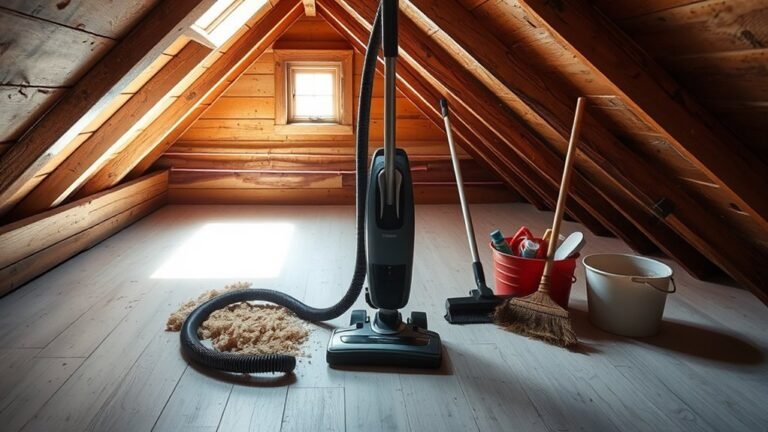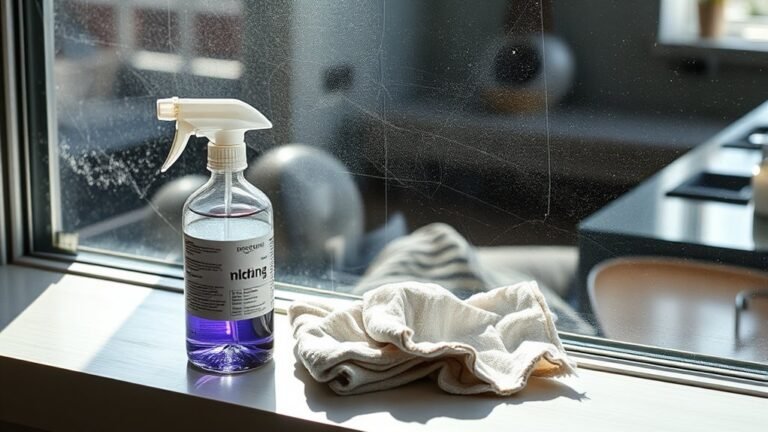How to Clean Artificial Plants and Flowers
To keep your artificial plants looking fresh, start by gathering soft cloths, brushes, and gentle cleaning sprays. Dust regularly with a soft brush or microfiber cloth to avoid buildup. For deeper cleaning, wipe leaves with a mild soap solution or a mix of vinegar and water, then air dry thoroughly. Silk flowers need gentle dusting without soaking. With proper care and regular maintenance, you’ll enjoy vibrant plants longer. Explore different methods to find what works best for your setup.
Gather Your Cleaning Supplies

Before you begin, make sure you have all the necessary cleaning supplies on hand. Having the right cleaning tools ready saves you time and lets you clean your artificial plants efficiently, so you can get back to enjoying your space. Simple items like a soft cloth, a small brush, and a gentle cleaning spray are essential. You might also want a spray bottle filled with water for a quick rinse. Remember, the key to maintaining your plants’ fresh look without hassle is sticking to a regular cleaning frequency. Cleaning them every few weeks prevents dust buildup and keeps your artificial greenery vibrant. With the right tools and a steady schedule, you’ll keep your plants looking effortlessly beautiful and free from dirt.
Dusting Techniques for Artificial Plants
When dust starts to settle on your artificial plants, using a soft bristle brush can gently remove particles without damaging the leaves. You can also try compressed air to blow away dust from hard-to-reach spots. These simple tools help keep your plants looking fresh with minimal effort.
Soft Bristle Brushes
One of the simplest tools you can use to keep your artificial plants dust-free is a soft bristle brush. These brushes offer gentle cleaning without damaging delicate leaves or flowers, highlighting the soft bristle benefits. When choosing bristle types, opt for natural or synthetic bristles that match your plant’s texture to avoid wear. Using the right brush lets you maintain your plants effortlessly, freeing you from harsh chemicals or complicated routines.
Consider these tips for ideal dusting:
- Select a brush with flexible bristles for intricate details
- Use a gentle sweeping motion to lift dust without crushing
- Clean the brush frequently to avoid redistributing dust
- Target hard-to-reach areas like leaf bases and stems
- Store brushes in a dry place to preserve bristle quality
This simple tool keeps your artificial greenery fresh and inviting with minimal effort.
Compressed Air Use
Besides soft bristle brushes, compressed air offers a quick and effective way to remove dust from your artificial plants, especially in tight spots brushes can’t reach. With compressed air techniques, you can effortlessly blow away dirt from crevices and delicate leaves without touching or damaging them. One of the biggest compressed air benefits is that it keeps your hands clean and avoids moisture, which can cause mold or discoloration. Just hold the nozzle a few inches away and use short bursts to dislodge dust. This method gives you freedom to clean intricate arrangements swiftly and thoroughly, even those hard-to-reach places. So, keep a can of compressed air handy—it’s a simple, mess-free tool that helps maintain your artificial greenery’s fresh look anytime you want.
Washing With Soapy Water

Although artificial plants don’t need frequent washing, using soapy water is an effective way to remove dust and grime buildup. You’ll want to find a gentle soap mixed with lukewarm water to keep your plants looking fresh without damage. Consider your cleaning frequency based on where your plants live—more often in dusty spots, less in cleaner areas.
Here’s how to wash with soapy water:
- Fill a basin with lukewarm water and add a few drops of mild soap
- Dip a soft cloth or sponge into the soapy water
- Gently wipe leaves and stems, avoiding harsh scrubbing
- Rinse with clean water to remove soap residue
- Let your plants air dry completely before placing them back
This method gives you control over freshness while protecting your artificial greenery’s freedom to shine.
Using Vinegar Solutions for Deeper Cleaning
If your artificial plants need a deeper clean, a vinegar solution can work wonders. You’ll want to mix the right ratio—usually one part vinegar to three parts water—and apply it carefully to avoid damage. Just be sure to wear gloves and test a small area first to keep your plants safe.
Vinegar Mixture Ratios
One effective way to give your artificial plants a deeper clean is by using a vinegar solution, and getting the mixture ratios right is key. Vinegar benefits include its natural disinfecting and deodorizing properties, making it a powerful yet gentle cleaner. You can also explore vinegar alternatives like lemon juice or baking soda if you want a different scent or gentler approach.
Here are some ideal vinegar mixture ratios for cleaning:
- 1 part white vinegar to 3 parts water for regular cleaning
- 1 part white vinegar to 1 part water for tougher grime
- Add a few drops of dish soap for extra grease-cutting power
- Use distilled vinegar to avoid residue
- Avoid pure vinegar to prevent damage
These ratios give you freedom to clean effectively without harming your plants.
Application Techniques
Getting the most out of your vinegar solution means applying it correctly to reach every nook and cranny of your artificial plants. Start by placing your plants in a sink or basin, then use a soft cloth or sponge dipped in the vinegar mixture to gently wipe each leaf and stem. For stubborn dust or grime, a soft-bristled brush works wonders. Avoid soaking plants directly to prevent damage. Stick to a cleaning frequency that fits your lifestyle—once a month usually keeps them fresh without hassle. Integrate this into your maintenance schedule so it becomes a simple, freeing routine rather than a chore. With consistent, targeted application, your artificial plants will stay vibrant and inviting, giving you more freedom to enjoy your space without constant upkeep.
Safety Precautions
Three key safety precautions should guide you when using vinegar solutions for cleaning your artificial plants. Since vinegar is acidic, it can pose chemical hazards if mishandled. To keep your cleaning process free and safe, always wear proper safety gear and take these steps:
- Use gloves and eye protection to avoid skin and eye irritation
- Work in a well-ventilated area to minimize inhaling fumes
- Dilute vinegar with water to reduce acidity and potential damage
- Test the solution on a small part of the plant before full application
- Store vinegar solutions away from children and pets to prevent accidental exposure
Cleaning Silk Flowers Safely
Although silk flowers don’t require frequent cleaning, dust and dirt can quickly dull their appearance if you don’t handle them carefully. To maintain silk flower longevity, it’s best to incorporate seasonal cleaning into your routine. Start by gently dusting with a soft brush or using a hairdryer on a cool, low setting to blow away debris. Avoid harsh chemicals or soaking them, as moisture can damage delicate fibers. When cleaning, hold each flower securely to prevent bending or tearing stems and petals. Taking these simple steps guarantees your silk flowers stay vibrant and fresh without risking damage. By treating them with care, you keep your space beautiful and enjoy the freedom of low-maintenance décor that lasts through every season.
Drying Methods to Prevent Damage

When you clean artificial plants, how you dry them is just as important as the cleaning process itself. Using the right drying techniques guarantees moisture prevention, which helps avoid damage like warping or mold buildup. To keep your plants looking fresh and vibrant, try these tips:
- Gently shake off excess water before drying.
- Pat leaves and petals with a soft, absorbent cloth.
- Air-dry plants in a well-ventilated area away from direct sunlight.
- Use a fan on a low setting to speed up drying without heat.
- Avoid using hairdryers or heaters, as excessive heat can cause fading or deformation.
Maintaining Artificial Plants Between Cleanings
To keep your artificial plants looking their best between cleanings, you’ll want to adopt simple daily habits that prevent dust and dirt buildup. Regular upkeep is key—you don’t need to deep clean every day, but a quick dusting with a microfiber cloth or a gentle shake can work wonders. Position your plants away from windows where dust tends to settle heavily, or use a small fan occasionally to keep the air moving and dust at bay. Avoid placing them near vents that blow dust around. These small steps in dust prevention save you time and effort later. By staying consistent with these habits, your artificial plants will stay fresh and vibrant, giving you the freedom to enjoy their beauty without constant maintenance.
Tips for Cleaning Large or Delicate Arrangements
Since large or delicate artificial plant arrangements can be tricky to clean, you’ll want to approach them with extra care and the right tools. To maintain arrangement stability and avoid damage, consider adjusting your cleaning frequency based on dust buildup and exposure. Here are some tips to keep your arrangements fresh without risking harm:
- Use a soft brush or microfiber cloth for gentle dusting.
- Avoid soaking; instead, use a spray bottle with diluted soap.
- Lay the arrangement flat to prevent bending or breaking stems.
- Check joints and wires regularly to verify they’re secure.
- Clean in a well-ventilated area to speed drying and prevent mold.
Frequently Asked Questions
Can Artificial Plants Improve Indoor Air Quality?
You might think artificial plants can boost air quality, but they actually don’t filter or improve it like real ones do. However, they do offer a unique way to enhance your indoor aesthetics without the hassle of maintenance. If you want freedom from watering or sunlight worries, these faux beauties keep your space lively and fresh-looking, giving you stylish decor that’s low effort, even if they don’t contribute to cleaner air.
Are Certain Artificial Plants Better for Allergy Sufferers?
You want freedom from allergy triggers, but also the beauty plants bring. While real plants can release pollen, certain artificial plant materials won’t. You’ll find that high-quality silk or plastic plants are generally better for allergy sufferers since they don’t emit allergens. So, if you crave greenery without sneezing fits, choosing the right artificial materials lets you embrace nature’s charm without sacrificing your comfort or freedom indoors.
How Long Do Artificial Plants Typically Last?
You’ll find that the lifespan of artificial plants varies depending on lifespan factors like exposure to sunlight and dust. Material durability plays a huge role—high-quality silk or plastic plants can last several years without fading or breaking down. If you take care to keep them out of harsh conditions, your artificial plants will keep looking fresh, giving you the freedom to enjoy their beauty without constant replacement or upkeep.
Can Artificial Plants Be Recycled or Are They Eco-Friendly?
Think of artificial plants as a double-edged sword. While some are made from eco-friendly materials like silk or biodegradable plastics, many contain mixed plastics that aren’t easy to recycle. Your recycling options might be limited, so you’ll need to check local facilities. If you want to stay green, opt for plants crafted from sustainable materials, or repurpose them creatively to keep your space fresh without harming the planet.
What Are the Best Storage Tips for Artificial Plants During Off-Season?
When storing your artificial plants off-season, you’ll want to focus on proper packaging to keep them safe and dust-free. Use breathable containers or boxes lined with acid-free tissue paper to prevent damage. Controlling humidity is key—store them in a dry place to avoid moisture buildup that can cause mold or fading. This way, you’ll keep your plants looking fresh and ready to brighten your space whenever you want, without hassle.






